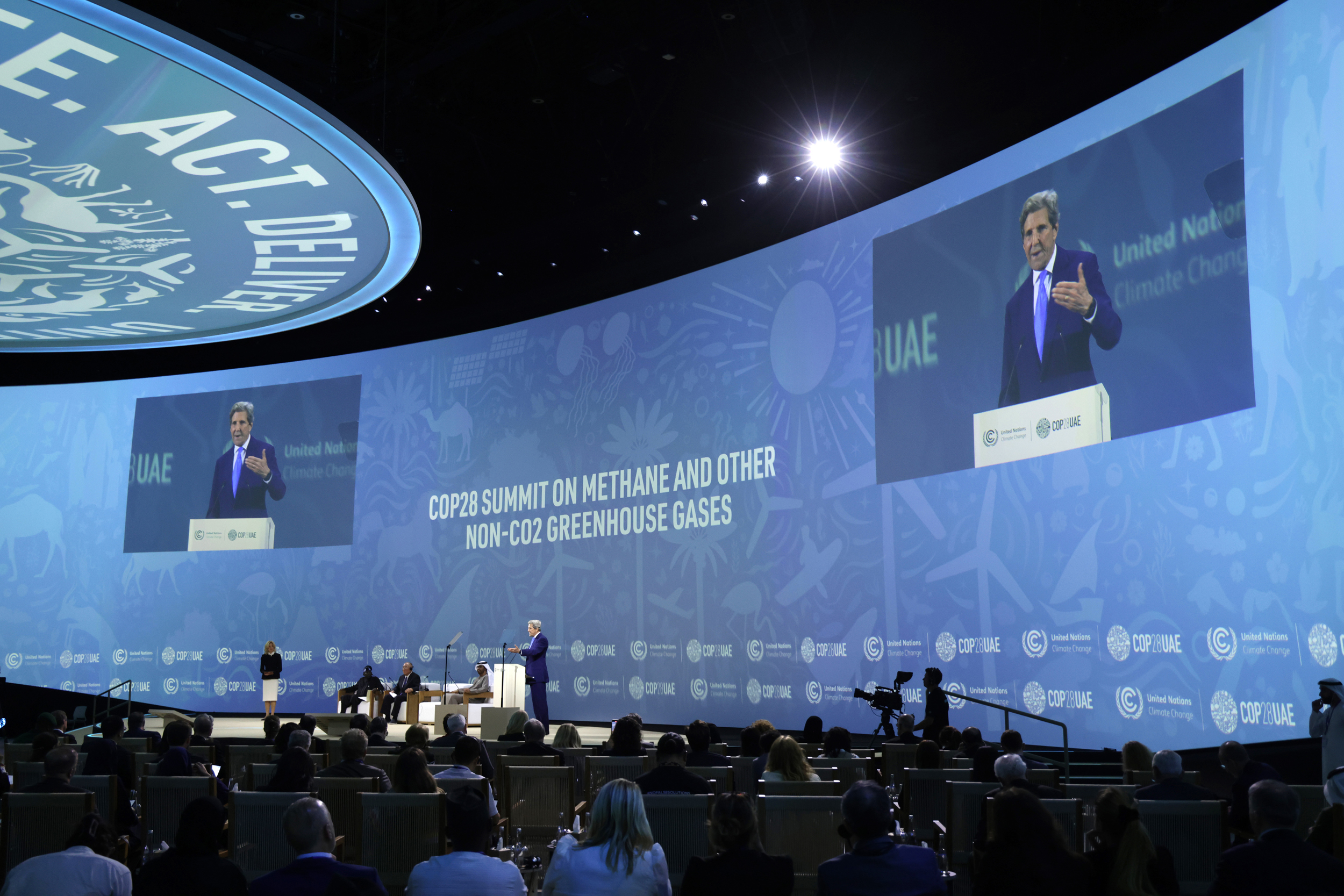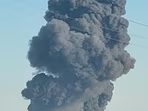Surging Methane Emissions Could Be a Sign of a Major Climate Shift
A 2021 pledge by more than 100 nations to cut methane emissions from anthropogenic sources 30 percent by 2030 might not slow global warming as much as projected, as new research shows that feedbacks in the climate system are boosting methane emissions from natural sources, especially tropical wetlands.
A new trouble spot is in the Arctic, where scientists recently found unexpectedly large methane emissions in winter. And globally, the increase in water vapor caused by global warming is slowing the rate at which methane breaks down in the atmosphere. If those feedbacks intensify, scientists said, it could outpace efforts to cut methane from fossil fuel and other human sources.
Methane traps about 80 times more heat than carbon dioxide over a 20-year period and scientists estimate it’s responsible for 20 to 30 percent of climate warming since the start of the industrial age, when atmospheric methane was at a concentration of about 0.7 parts per million. It has zig-zagged upward since then, spiking with the first fossil gas boom in the 1980s, then leveling off slightly before a huge surge started in the early 2000s. The amount of methane in the atmosphere reached about 1.9 ppm in 2023, nearly three times the pre-industrial level.
About 60 percent of methane emissions are from fossil fuel use, farming, landfills and waste, with the rest coming from rotting vegetation in wetlands in the tropics and Northern Hemisphere. In a paper published July 30 in Frontiers in Science, an international team of researchers wrote that “Rapid reductions in methane emissions this decade are essential to slowing warming in the near future … and keeping low-warming carbon budgets within reach.”
Explore the latest news about what’s at stake for the climate during this election season.
The scientists found that the abrupt surge in methane emissions in the early 2000s is probably due mainly to the response of wetlands to warming, with additional contributions coming from fossil fuel use, “implying that anthropogenic emissions must decrease more than expected to reach a given warming goal.”
Increasing rainfall, a well-documented impact of global warming, is making wetlands larger and wetter, and a warmer world fosters more plant growth, which means more decomposing material that emits methane.
The increase of methane from natural sources should spur even more efforts to cut emissions wherever possible, including from fossil fuel use and agriculture, said lead author Drew Shindell, an Earth scientist with Duke University’s Nicholas School of the Environment.
Recent measurements by a specially equipped jet show that methane emissions from oil and gas operations in the United States are more than four times higher than EPA estimates and eight times greater than fossil industry targets. Addressing methane emissions from anthropogenic sources is a crucial part of the climate action equation, Shindell said, including those from agriculture.
“If we reduced those we’d see a large decrease in atmospheric concentrations,” he said. “But cutting emissions from agriculture in particular is improbable in the near-term, and maybe even in the long term.”
The study re-affirmed that rapid methane cuts are “essential to slowing warming in the near future, limiting overshoot by the middle of the century and keeping low-warming carbon budgets within reach.” The researchers noted that the costs of reducing methane emissions are low compared to many other climate mitigations, and that “legally binding regulations and widespread pricing are needed” to encourage the deep cuts that are needed.”
Study Finds New Methane Sources From Dry Permafrost
Scientists determine the source of methane by examining its carbon isotopes, and since 2007, those evaluations show that the signal of methane produced from biological sources “has been getting much stronger,” said Euan Nisbet, an atmospheric scientist and methane expert at the University of Cambridge who was not involved in the new paper.
“There are two explanations, both of them probably correct,” he said. “One is that there are a lot more cows puffing out. But the other one is that the natural wetlands are turning on. That happens in the tropics first, and then the permafrost melts in Canada, and suddenly you get all sorts of methane coming off the Canadian swamps and the Siberian swamps as they wet up.”
Even cold, dry regions in the Arctic contribute to climate-warming methane pollution more than previously thought, according to a July 18 paper in Nature Communications that looked at dry permafrost areas called upland Yedoma Taliks found predominantly in northern Siberia, where permafrost thaw likely will speed up methane production as microbes break down organic material.
“Dry upland soils spatially dominate the 17.8 million square kilometer permafrost region,” the researchers wrote, describing silt-dominated, ice-supersaturated areas that have been frozen since they first formed in the steppe-tundra regions of Siberia, Alaska and Northwest Canada during the late Pleistocene, about 100,000 to 12,000 years ago.
The study found annual methane emissions from thawing upland Yedoma taliks were, acre for acre, almost triple those of emissions from northern wetlands; much larger than currently predicted by climate models, the authors of the Nature study said.
The findings are of concern because existing permafrost models don’t distinguish between permafrost soil types or account for winter emissions, the researchers wrote. The world’s permafrost holds three times as much carbon as is currently in the atmosphere, in a region warming three to four times faster than the global average.
For Nisbet, the recent findings, along with his own research, are warning signs that methane emissions may be reaching the level of what paleoclimate researchers call “climate terminations,” which in the recent geological past marked the shift from long, cold glacial periods to warmer interglacial times.
The transitions generally took thousands of years, with slow warming initially, and then a very fast shift that signals the onset of ice caps melting. During the most recent termination, about 15,000 years ago, there was a period when Greenland’s temperature rose by about 18 degrees Fahrenheit in just a few decades.
“In those phases, methane levels climb very steeply,” Nisbet said. The increase in emissions since the early 2000s is a worrisome parallel to those climate terminations, with the current trajectory of methane similar to that at the end of the last ice age, he said.
A Climate Shift?
There are other signs of Earth at a tipping point, including the ominously rapid increase of Earth’s annual average temperature in the past year, during which every month set a new record high.
In a March essay in Nature, Gavin Schmidt, director of the NASA Goddard Institute for Space Studies in New York, wrote that the unexpected 2023 heat surge of heat shows a “knowledge gap” that may call into question the reliability of some climate models.
Other leading scientists, including Johan Rockström, director of the Potsdam Institute for Climate Impact Research, have voiced similar concerns.
“The planet is changing faster than we have expected,” he said during a July TED Talk. “We are, despite years of raising the alarm, now seeing that the planet is actually in a situation where we underestimated risks. Abrupt changes are occurring in a way that is way beyond the realistic expectations in science.” Later he wrote on X, “Tipping points are approaching fast.”
At the COP28 climate conference in Dubai last year, Rockström was part of a team of scientists warning about climate tipping points “of a magnitude that has never been faced before by humanity.”

Another recent study, published July 11 in Science, found that methane persists in the atmosphere longer than most climate models estimate. The gas is not breaking down in the atmosphere as fast as thought because global warming has added more water vapor to the atmosphere.
At the current level of warming, about 2 degrees Fahrenheit above the pre-industrial baseline, the atmosphere can hold about 7 percent more moisture, and the study shows that water vapor absorbs some of the ultraviolet light, which is needed for the creation of hydroxyl radicals, key molecules that break down methane.
Those molecules “are called the detergent of the atmosphere,” said Nisbet, the Cambridge climate researcher. “They go and clean up all the nasties.” The finding that methane may persist longer than believed makes the global goal of cutting methane emissions by 30 percent in six short years even more important, he added.
In keeping with the 2015 Paris climate accord, the methane goal is aimed at holding global heating well below 2 degrees Celsius above the pre-industrial level, and as close to 1.5 degrees Celsius as possible, to avoid tipping points that could bring rapid changes to the climate system.
He said that, along with the increases in methane and the recent global temperature surge, the recent winter heatwave in Antarctica is yet another possible sign of a major climate disruption in progress.
“It’s almost as if the planet is doing a stick shift, and what happens then?” he asked.
“What happened before is the ocean currents rearrange themselves, the wind belts rearrange themselves. The ocean currents move. The Atlantic overturning circulation changes, and that’s one of the real markers of a major climate shift. And, of course, that’s what’s happening at the moment.”
About This Story
Perhaps you noticed: This story, like all the news we publish, is free to read. That’s because Inside Climate News is a 501c3 nonprofit organization. We do not charge a subscription fee, lock our news behind a paywall, or clutter our website with ads. We make our news on climate and the environment freely available to you and anyone who wants it.
That’s not all. We also share our news for free with scores of other media organizations around the country. Many of them can’t afford to do environmental journalism of their own. We’ve built bureaus from coast to coast to report local stories, collaborate with local newsrooms and co-publish articles so that this vital work is shared as widely as possible.
Two of us launched ICN in 2007. Six years later we earned a Pulitzer Prize for National Reporting, and now we run the oldest and largest dedicated climate newsroom in the nation. We tell the story in all its complexity. We hold polluters accountable. We expose environmental injustice. We debunk misinformation. We scrutinize solutions and inspire action.
Donations from readers like you fund every aspect of what we do. If you don’t already, will you support our ongoing work, our reporting on the biggest crisis facing our planet, and help us reach even more readers in more places?
Please take a moment to make a tax-deductible donation. Every one of them makes a difference.
Thank you,
David Sassoon
Founder and Publisher
Vernon Loeb
Executive Editor
Share this article
Disclaimer: The copyright of this article belongs to the original author. Reposting this article is solely for the purpose of information dissemination and does not constitute any investment advice. If there is any infringement, please contact us immediately. We will make corrections or deletions as necessary. Thank you.
Title:Surging Methane Emissions Could Be a Sign of a Major Climate Shift
Url:https://www.investsfocus.com








